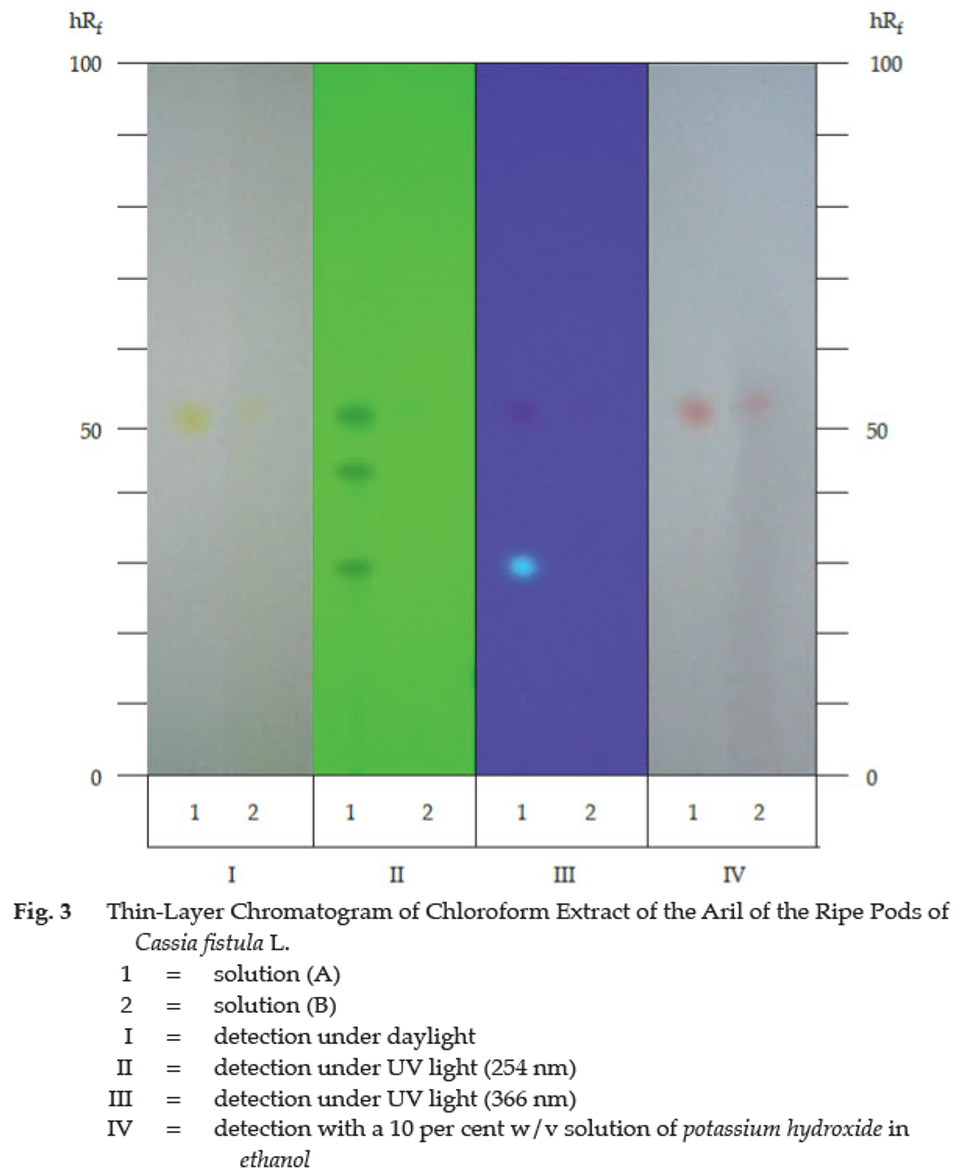ตำรามาตรฐานยาสมุนไพรไทย
Thai Herbal Pharmacopoeia
สำนักยาและวัตถุเสพติด กรมวิทยาศาสตร์การแพทย์ กระทรวงสาธารณสุข
Bureau of Drug and Narcotic, Department of Medical Sciences, Ministry of Public Health(Tinospora crispa (L.) Hook.f. & Thomson)
(Nelumbo nucifera Gaertn.)
(Centella asiatica (L.) Urb.)
(Centella Dry Extract)
(Centella Cream)
(Mesua ferrea L.)
(Piper sarmentosum Roxb.)
(Piper sarmentosum Roxb.)
(Pterocarpus santalinus L. f.)
(Santalum album L.)
(Senna tora (L.) Roxb.)
(Senna alata (L.) Roxb.)
(Senna Alata Tea)
(Piper retrofractum Vahl)
(Myristica fragrans Houtt)
(Andrographis paniculata (Burm. f.) Nees)
(Andrographis Capsules)
(Allium ascalonicum L.)
(Ocimum tenuiflorum L.)
(Curcuma longa L.)
(Turmeric Capsules)
(Turmeric Dry Extract)
(Turmeric Dry Extract Capsules)
(Arcangelisia flava (L.) Merr.)
(Curcuma sp.)
Harrisonia perforata (Blanco) Merr.
(Aristolochia pierrei Lecomte)
(Zingiber officinale Roscoe)
(Ginger Capsules)
(Ginger Tea)
(Cassia fistula L.)
(Nardostachys jatamansi (D. Don) DC.)
(Angelica sinensis (Oliv.) Diels)
Artemisia annua L.
(Ligusticum sinense Oliv. cv. Chuanxiong)
(Neopicrorhiza scrophulariiflora Pennell)
(Atractylodes lancea (Thunb.) DC.)
(Aucklandia lappa Decne)
(Terminalia chebula Retz.)
(Angelica dahurica (Hoffm.) Benth. & Hook. f. ex Franch. & Sav. var. dahurica)
(Kaempferia parviflora Wall. ex Baker)
(Hibiscus sabdariffa L.)
(Roselle Tea)
(Allium sativum L.)
(Zingiber zerumbet (L.) Sm.)
(Wurfbainia testacea (Ridl.) Škorničk.& A. D. Poulsen)
(Cannabis sativa L.)
(Myristica fragrans Houtt)
(Dracaena cochinchinensis (Lour.) S. C. Chen)
(Ficus racemosa L.)
(Hyptis suaveolens (L.) Poit.)
Clerodendrum indicum (L.) Kuntze
(Phyllanthus emblica L.)
(Citrus hystrix DC.)
(Citrus hystrix DC.)
(Areca catechu L.)
(Momordica charantia L.)
Moringa oleifera Lam.
(Aegle marmelos (L.) Corrêa)
(Solanum trilobatum L.)
(Morus alba L.)
Gynostemma pentaphyllum(Thunb.)
Makino
(Clinacanthus nutans (Burm. f.) Lindau)
(Cissus quadrangularis L.)
(Mimusops elengi L.)
(Zingiber montanum (J. König) Link. ex A. Dietr.)
(Piper betle L.)
(Capsicum annuum L.)
(Capsicum Oleoresin)
(Capsicum Gel)
(Piper nigrum L.)
(Piper nigrum L.)
(Eurycoma longifolia Jack)
(Thunbergia laurifolia Lindl.)
(Piper wallichii (Miq.) Hand.-Mazz.)
Senna garrettiana (Craib) H. S. Irwin & Barneby
(Terminalia bellirica (Gaertn.) Roxb.)
(Terminalia chebula Retz.)
(Caesalpinia bonduc (L.) H. Roxb.)
(Tarlmounia elliptica (DC.) H. Rob., S. C. Keeley, Skvaria & R. Chan)
(Hog Creeper Vine Dry Extract Capsiles)
(Hog Creeper Vine Dry Extract)
(Brachypterum scandens (Roxb.) Miq.)
(Lepidium sativum L.)
(Nigella sativa L.)
(Cuminum cyminum L.)
(Foeniculum vulgare Mill.)
(Plantago ovata Forssk.)
(Pimpinella anisum L.)
(Carum carvi L.)
(Anethum graveolens L.)
(Trachyspermum ammi (L.) Sprague)
Albizia procera (Roxb.) Benth.
(Acorus calamus L.)
(Tiliacora triandra (Colebr.) Diels)
Cyanthillium cinereum (L.) H. Rob.
(Orthosiphon aristatus (Blume) Miq.)
Murdannia loriformis (Hassk.) R. S. Rao & Kammathy
(Capparis micracantha DC.)
(Chrysopogon zizanioides (L.) Roberty)
(Cyperus rotundus L.)
(Cannabis sativa L.)
(Syzygium aromaticum (L.) Merr. & L. M. Perry)
(Boesenbergia rotunda (L.) Mansf.)
(Acanthus ebracteatus Vahl)
(Acanthus ilicifolius L.)
(Kaempferia galanga L.)
(Curcuma comosa Roxb.)
Betula alnoides Buch.-Ham. ex D. Don
Cannabis sativa L.
Carthamus tinctorius L
Mitragyna speciosa (Korth.) Havil
Mallotus repandus (Rottler) Müll. Arg
Azadirachta indica A. Juss. var. siamensis Valeton
Azadirachta indica A. Juss. var. siamensis Valeton
Punica granatum L.
Rhinacanthus nasutus (L.) Kurz
Baliospermum solanifolium (Burm.) Suresh
Curcuma aeruginosa Roxb
Boesenbergia kingii Mood & L. M. Prince
Senegalia rugata (Lam.) Britton & Rose
Acacia concinna (Willd.) DC.
Senegalia rugata (Lam.) Britton & Rose
Acacia concinna (Willd.) DC.
Senna alexandriana Mill. var. alexandriana
Cassia acutifolia Delile, Cassia angustifolia Vahl
Butea superba Roxb. ex Willd.
[Plaso superba (Roxb. ex Willd.) Kuntze, Rudolphia superba (Roxb. ex Willd.) Poir.
Pueraria candollei Graham
ex Benth. var. mirifica (Airy Shaw & Suvat.) Niyomdham
Streblus asper Lour.
Suregada multiflora (A. Juss.) Baill. (Gelonium
multiflorum A. Juss.
Purging Cassia Pulp is the aril of the ripe pod of Cassia fistula L. (Family Leguminosae), Herbarium Specimen Number: DMSC 5162, BKF 114900, Crude Drug Number: DMSc 1142
Constituents Purging Cassia Pulp contains anthraquinones (e.g., rhein and its glycosides). It also contains flavonoids, tannins, etc.
Description of the plant (Figs. 1a, 1b) Deciduous tree, up to 20 m tall; bark smooth, greenish grey when young, becoming rough and dark brown when mature. Leaves pinnately compound, 10 to 60 cm long; petiole 7 to 10 cm long; rachis 15 to 25 cm long; stipule small and caducous; leaflets opposite, 3- to 8-paired, ovate to ovate-oblong, 6 to 20 cm long, 3.5 to 9 cm wide, apex acute to acuminate, base cuneate, upper surface glabrous, lower surface silvery pubescent when young, becoming glabrous when mature. Inflorescence raceme, axillary, drooping, lax, many-flowered, 20 to 40(‒60) cm long; pedicel 1.5 to 5 cm long; bract about 1 cm long, caducous. Flower: sepals 5, ovate-elliptic, about 1 cm long, velutinous, reflexed at anthesis; petals 5, subequal, broadly ovate or obovate, 2 to 3.5 cm long, 1 to 2 cm wide, distinctly veined, short-clawed, yellow; stamens 10, 3 long, 4 short and 3 reduced forms, long stamens much curled and bearing large oblong anther, opening by apical and basal slits, short stamens with straight filaments, reduced stamens with minute anther; ovary stalked, velutinous, style velutinous, stigma small. Fruit pod, terete, 20 to 60 cm long, 1 to 2.5 cm wide, pendulous, indehiscent, blackish brown to black. Seeds numerous, elliptic, 7.5 to 9 mm long, 5 to 7 mm wide, flat, glossy brown, embedded in blackish pulp, separated by spongy septa.
Description Odour, characteristic; taste, unpleasantly sweet.
Macroscopical (Fig. 1a) Sticky lump of pulp, dark brown to black.
Microscopical [Note Even though the pulp (aril) is used as a crude drug, microscopical description of the young pod is provided here for better understanding of the entire structure enclosing the pulp and the seed within.] (Figs. 2a, 2b, 2c, 2d) Transverse section of the pod shows pericarp and seed. Pericarp, consisting of a rectangular epidermal layer (rarely with unicellular trichome), parenchyma cells some of which containing prismatic crystals, vascular bundles, and layers of elongated sclereids. Seed, containing aril and seed coat; aril, parenchyma cells, some of which containing rosette aggregate crystals; seed coat, covered with thick cuticle layer, layers of non-lignified macrosclereids and two layers of non-lignified lagenosclereids separated by layers of thick-walled parenchyma.
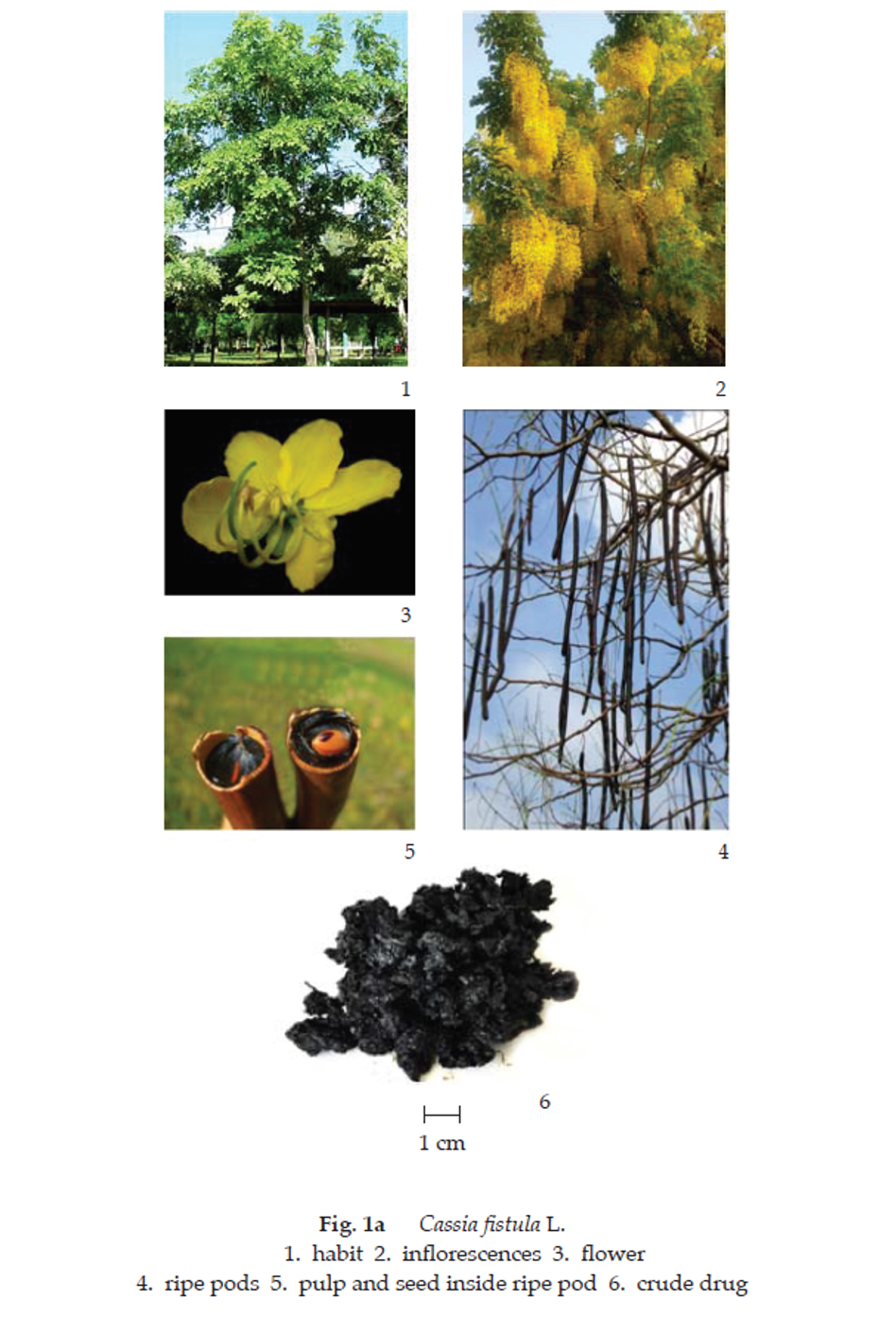
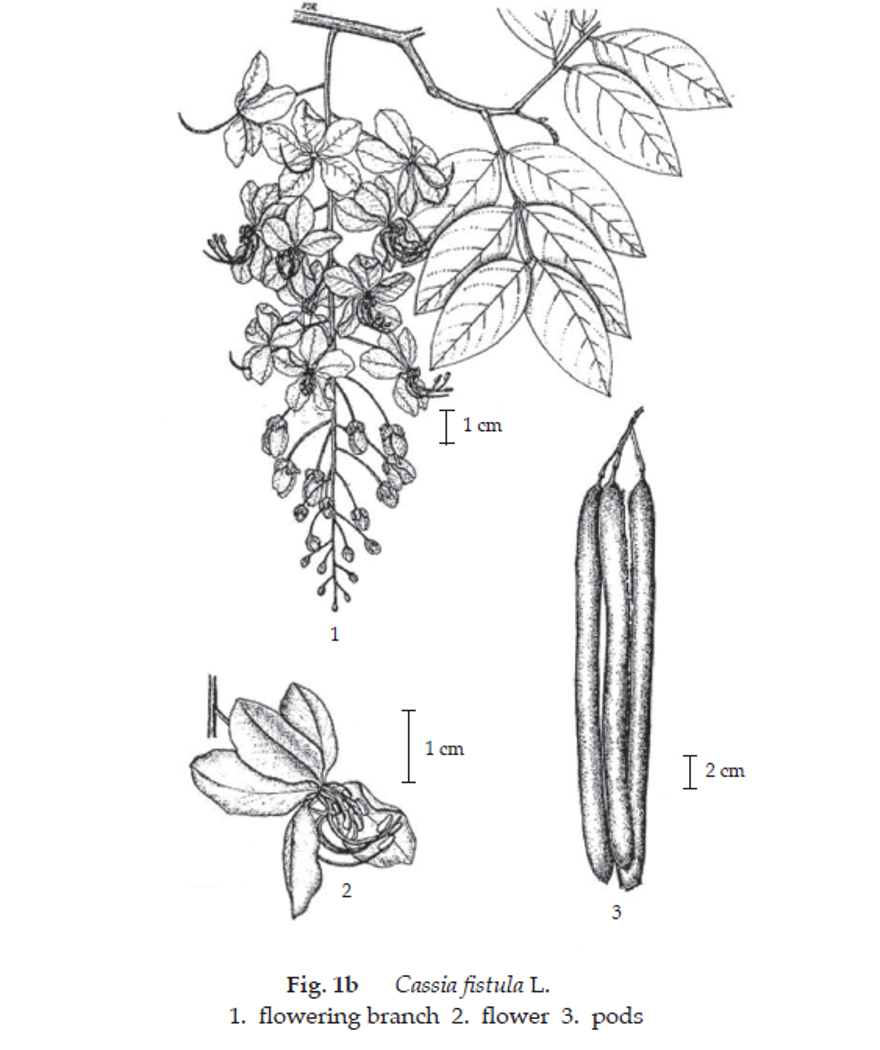
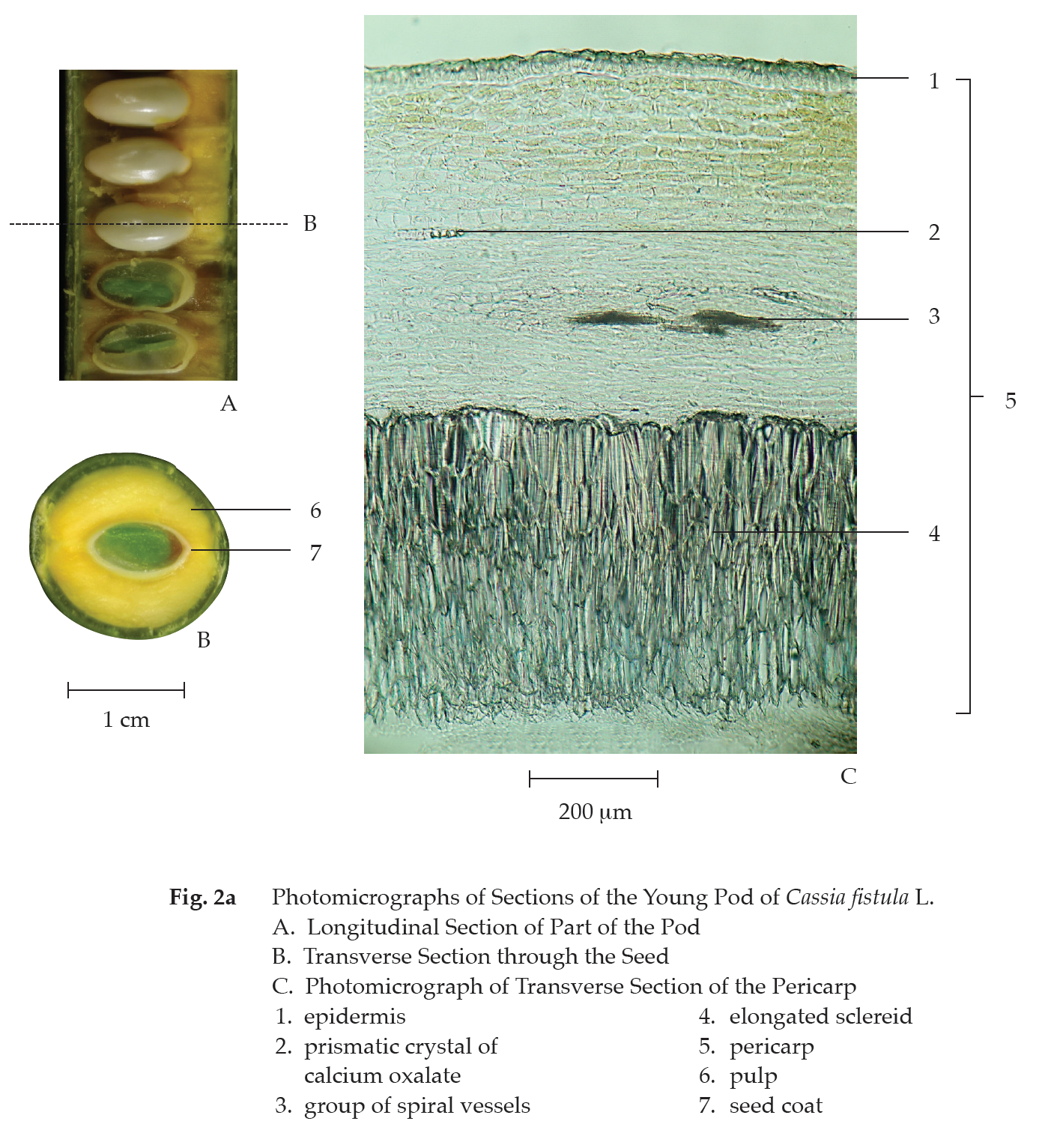

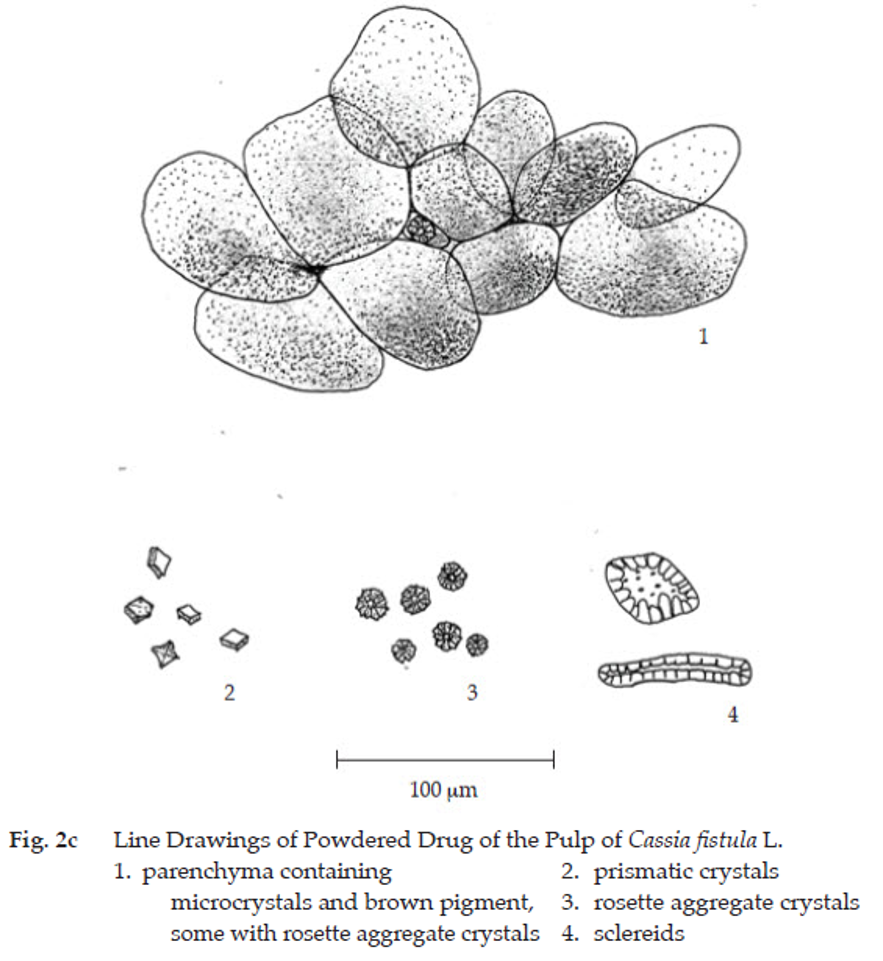
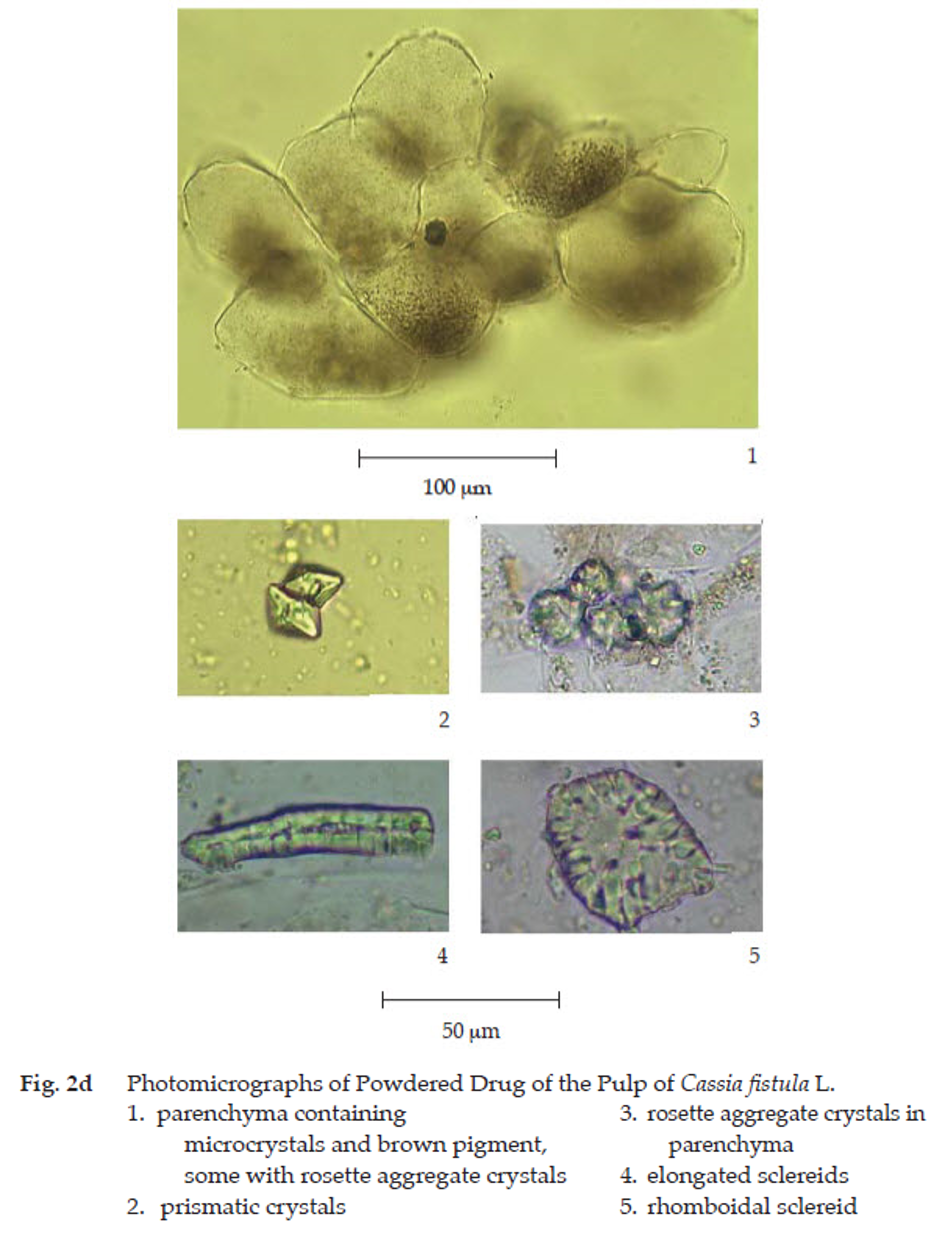
Purging Cassia Pulp possesses the diagnostic microscopical characters of the aril of the drug. The parenchyma cells containing brownish to blackish granular mass is characteristic.
Contra-indication It is contra-indicated in patients with constipation from intestinal obstruction, diarrhoea, abdominal pain, nausea, and vomiting.
Warning
1. Prolonged use should be avoided since it may result in laxative dependence.
2. Pod shell and seeds should be removed from the pulp since they may cause vomiting.
Additional information
1. Although in Thai traditional remedies the crude drug is usually addressed as “ฝักคูน (FAK KHUN)” which means a purging cassia pod, only the pulp after removal of shell and seeds [เนื้อในฝักคูน (KHUN, NUEA NAI FAK)] is used in the preparations. Therefore, it is chosen to be the title of this monograph.
2. To obtain its maximum benefit, it is recommended that the pulp be freshly taken from the purging cassia pod.
Packaging and storage Purging Cassia Pulp shall be kept in well-closed containers, protected from light, and stored in a dry place.
Identification
A. To 3 g of the sample, add 25 mL of 2 M hydrochloric acid, heat on a water-bath for 30 minutes, and immediately filter through a plug of cotton wool. Allow the filtrate to cool and shake with 20 mL of dichloromethane. Collect the dichloromethane layer and shake with 10 mL of ammonia TS: the aqueous layer becomes red.
B. Carry out the test as described in the “Thin-Layer Chromatography” (Appendix 3.1), using silica gel GF254 as the coating substance and a mixture of 100 volumes of ethyl acetate, 17 volumes of methanol and 3 volumes of water as the mobile phase and allowing the solvent front to ascend 10 cm above the line of application. Apply separately to the plate, 4 μL each of the following solutions. Prepare solution (A) by refluxing 5 g of the sample with 50 mL of chloroform on a water-bath for 30 minutes, filtering and evaporating the filtrate to dryness. Dissolve the residue in 1.0 mL of chloroform. For solution (B) dissolve 3 mg of rhein in 1 mL of methanol. After removal of the plate, allow it to dry in air and examine under daylight, locating the spots. The chromatogram obtained from solution (A) shows a yellow spot corresponding to the rhein spot (hRf value 49 to 52) from solution (B). Subsequently examine under ultraviolet light (254 nm), marking the quenching spots. The chromatogram obtained from solution (A) shows a quenching spot corresponding to the rhein spot from solution (B), and other two quenching spots of the lower hRf values. Examine the plate under ultraviolet light (366 nm); the spot due to rhein is a brownish purple; one blue fluorescent spot is also observed. Spray the plate with a 10 per cent w/v solution of potassium hydroxide in ethanol; the spot corresponding to rhein is reddish pink (Table 1); see also Fig. 3.
Table 1 hRf Values of Components in Chloroform Extract of the Aril of the Ripe Pods of Cassia fistula L.
| Spot | hRf Value | Detection | |||
| Daylight | UV 254 | UV 366 | 10 Per Cent W/V Solution of Potassium Hydroxide in Ethanol |
||
| 1 2 3 4* |
25-28 30-32 40-44 49-52 |
- - - yellow |
quenching - quenching quenching |
- blue - brownish purple |
- - - reddish pink |
*rhein
Loss on drying Not more than 14.0 per cent w/w after drying at 105° to constant weight (Appendix 4.15).
Foreign matter Not more than 2.0 per cent w/w (Appendix 7.2).
Total ash Not more than 4.0 per cent w/w (Appendix 7.7).
Ethanol-soluble extractive Not less than 66.0 per cent w/w (Appendix 7.12).
Water-soluble extractive Not less than 67.0 per cent w/w (Appendix 7.12).
Dose 3 to 10 g at bed time.
